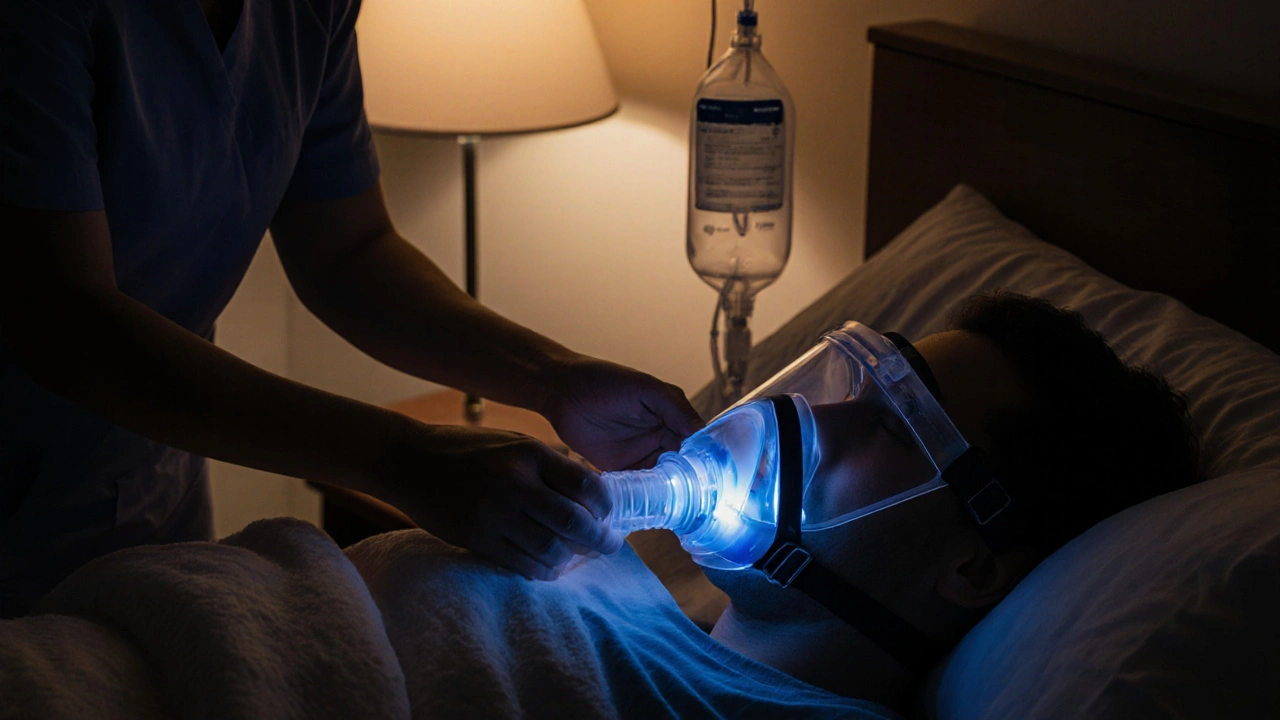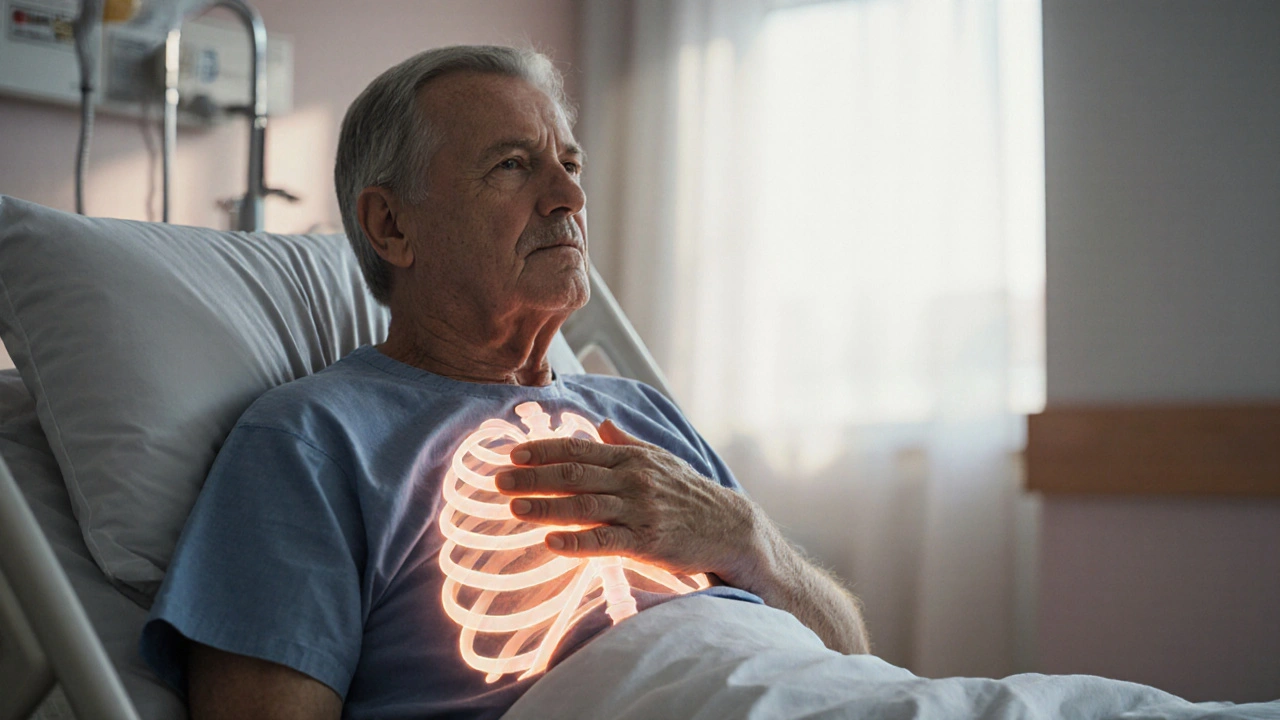Myasthenia Gravis Respiratory Strength Calculator
Assess Your Respiratory Function
This tool helps you understand your respiratory strength based on your Forced Vital Capacity (FVC) measurement. FVC is a key indicator of breathing muscle strength in Myasthenia Gravis. Results are categorized using the thresholds described in medical guidelines.
When the muscles that power every breath start to tire, the impact is immediate and frightening. For people living with Myasthenia Gravis, the disease’s hallmark muscle weakness often reaches the lungs, making everyday activities feel like a marathon. This guide explains why the respiratory system gets involved, how to spot early warning signs, and which tools-medicines, monitoring devices, and supportive therapies-can keep oxygen flowing smoothly.
Key Takeaways
- Myasthenia Gravis attacks the neuromuscular junction, weakening the diaphragm and intercostal muscles.
- Early signs of respiratory involvement include shortness of breath, nasal speech, and reduced cough strength.
- Routine tests such as spirometry and overnight oximetry help catch problems before they become a crisis.
- Medications (pyridostigmine, immunosuppressants) and procedures (thymectomy) target the immune attack, while respiratory support (non‑invasive ventilation) buys time during acute episodes.
- Prompt treatment of infections, vaccination, and staying aware of trigger factors dramatically lower the risk of a myasthenic crisis.
How Myasthenia Gravis Affects Breathing
Myasthenia Gravis is an autoimmune disorder where antibodies block acetylcholine receptors at the neuromuscular junction. This blockade stops nerve signals from telling muscles to contract. The respiratory system relies on two main muscle groups: the diaphragm and the intercostal muscles between the ribs. When the antibody attack spreads to these muscles, the diaphragm-an essential dome‑shaped muscle that lifts during inhalation-begins to fatigue. The result is a reduced volume of air exchanged with each breath, known as a lowered vital capacity.
Because breathing is continuous, even a slight drop in muscle strength can cause a cascade of symptoms. The body compensates by breathing faster (tachypnea) but this often feels like an unsettling shortness of breath that worsens after meals, during speech, or when lying flat. Over time, the weakened cough cannot clear secretions, increasing the risk of pneumonia-a common trigger for a myasthenic crisis.
Recognizing Early Respiratory Warning Signs
Spotting trouble early can prevent an emergency. Look for these clues:
- Sudden increase in breathing rate or feeling out of breath after minimal activity.
- Difficulty speaking in long sentences-voice may become nasal or shaky.
- Weak cough that fails to clear saliva or mucus.
- Nighttime awakening with gasping or choking sensations.
- Reduced ability to lift the head while lying flat (head‑lift test).
If any of these appear, schedule a pulmonary function test within 24-48hours. Early intervention often means adjusting medication rather than rushing to the ER.

Monitoring Tools You Can Trust
Regular objective measurements are the backbone of safe MG management. The most useful tests include:
- Spirometry: Measures forced vital capacity (FVC) and peak expiratory flow. An FVC below 80% of predicted signals worsening respiratory muscle strength.
- Sniff Nasal Pressure (SNP): A quick bedside test that gauges diaphragm strength by measuring the pressure generated from a sharp sniff.
- Overnight Oximetry: Records oxygen saturation while you sleep. Drops below 90% for more than a few minutes suggest nocturnal hypoventilation.
- Blood Gas Analysis: In acute settings, arterial CO₂ levels reveal how well the lungs are ventilating.
Keeping a log of these numbers-either on paper or a health‑app-helps your neurologist fine‑tune therapy before a crisis erupts.
Everyday Management Strategies
Medication remains the first line of defense. The cornerstone is pyridostigmine, a cholinesterase inhibitor that boosts the amount of acetylcholine available at the neuromuscular junction. Most patients start with a low dose (30mg three times daily) and titrate up until symptoms improve without excessive cramps.
For many, the immune system needs a second push. Corticosteroids (e.g., prednisone) rapidly dampen antibody production but carry long‑term side effects such as weight gain and bone loss. Steroid‑sparing agents-azathioprine, mycophenolate, or cyclosporine-are added to keep the steroid dose low.
When the thymus gland is abnormal (hyperplastic or harboring a tumor), surgical removal-known as thymectomy-has been shown in randomized trials to improve long‑term remission rates, especially in younger patients.
Beyond drugs, lifestyle tweaks matter. Maintaining a healthy weight eases the work of breathing, while regular gentle aerobic exercise (walking, stationary cycling) strengthens accessory muscles without overtaxing the primary respiratory muscles.
When a Myasthenic Crisis Hits
A myasthenic crisis is a rapid worsening of muscle weakness leading to respiratory failure. It often follows an infection, surgery, or sudden medication change. The hallmark is a sharp drop in FVC (often below 60% of predicted) accompanied by rising CO₂ levels.
Hospital treatment usually follows a three‑step protocol:
- Intensive monitoring: Continuous pulse‑oximetry, frequent arterial blood gases, and readiness for intubation.
- Immunomodulation: High‑dose intravenous immunoglobulin (intravenous immunoglobulin, IVIG) or plasma exchange (plasmapheresis) are the quickest ways to reduce circulating antibodies. IVIG is often preferred when vascular access is limited, while plasmapheresis provides a more immediate drop in antibody levels.
- Ventilatory support: If FVC falls below 15mL/kg or the patient cannot protect the airway, endotracheal intubation and mechanical ventilation become necessary.
After stabilization, the long‑term plan usually involves adjusting baseline immunosuppression to prevent future crises.
Supportive Breathing Therapies
Even when you’re not in a crisis, supplemental breathing aids can protect against night‑time hypoventilation. Non‑invasive ventilation (NIV) delivers positive airway pressure through a mask, easing the effort required by weakened muscles. Many patients start with a short nightly session and gradually increase duration based on comfort and oximetry readings.
Respiratory physiotherapy-guided deep‑breathing exercises, incentive spirometry, and assisted cough techniques-helps keep the lungs clear. A simple daily routine of three sets of 10 slow, deep breaths followed by a huff cough can dramatically reduce secretion buildup.

Prevention: Reducing the Risk of Respiratory Decline
Infections are the biggest trigger for worsening respiratory muscle strength. Keep vaccinations up to date: annual flu shot, pneumococcal vaccine every five years, and COVID‑19 boosters as recommended by health authorities. Hand hygiene, avoiding crowded indoor spaces during peak illness seasons, and prompt treatment of upper‑respiratory infections can stave off a crisis.
Medication compliance is equally vital. Skipping pyridostigmine doses or abruptly stopping steroids can precipitate rapid weakness. Use pillboxes or smartphone reminders to stay on track.
Finally, address comorbidities-such as sleep apnea or obesity-that add extra load to the respiratory system. A sleep study can reveal hidden apnea, which is often treatable with CPAP and significantly improves daytime breathing comfort.
Comparison of Key Respiratory Interventions
| Intervention | Mechanism | Onset of Action | Typical Use | Main Side Effects |
|---|---|---|---|---|
| Pyridostigmine | Cholinesterase inhibition increases acetylcholine at neuromuscular junction | 30‑60minutes | Baseline symptom control for mild‑moderate weakness | Diarrhea, abdominal cramps, excessive salivation |
| IVIG | Provides anti‑idiotype antibodies that neutralize pathogenic auto‑antibodies | 24‑48hours | Acute crisis or rapid worsening | Headache, aseptic meningitis, thromboembolic events |
| Plasmapheresis | Physically removes circulating antibodies from plasma | Within hours | Severe crisis when immediate reduction needed | Hypotension, bleeding, electrolyte shifts |
| Non‑invasive ventilation (NIV) | Positive airway pressure assists inspiratory effort | Immediate during use | Nocturnal hypoventilation, early crisis support | Mask discomfort, skin breakdown, aerophagia |
Next Steps for Patients and Caregivers
If you notice any breathing‑related symptom, schedule a pulmonary function test and contact your neurologist within a few days. Keep a daily log of medication times, FVC values, and any nighttime oxygen dips. Discuss with your doctor whether a thymectomy is appropriate for your age and thymus status.
For caregivers, learn the huff‑cough technique and have a rescue plan: emergency contact numbers, a list of current medications, and a clear instruction to seek immediate medical care if the patient cannot speak a full sentence or the oxygen saturation falls below 90%.
Frequently Asked Questions
Can Myasthenia Gravis cause long‑term lung damage?
If respiratory weakness is untreated, repeated infections and chronic hypoventilation can lead to bronchiectasis and reduced lung elasticity. Early monitoring and prompt treatment usually prevent permanent damage.
Is a sleep study necessary for every MG patient?
Not every patient needs one, but if you experience daytime fatigue, morning headaches, or snoring, a polysomnography can uncover sleep‑related breathing problems that worsen MG symptoms.
How quickly does IVIG work during a crisis?
Most patients notice improvement in muscle strength within 24‑48hours, though full recovery may take several days as the immune system recalibrates.
Can exercise worsen respiratory weakness?
Gentle, regular aerobic activity usually strengthens accessory muscles and improves endurance. Over‑exertion, however, can trigger fatigue, so keep sessions short (10‑15minutes) and monitor breathing.
When should I consider non‑invasive ventilation at home?
If overnight oximetry shows oxygen saturation below 90% for more than 5minutes, or if FVC consistently drops below 80% of predicted, discuss a trial of NIV with your pulmonologist.


Comments
Abdulraheem yahya October 14, 2025 AT 13:44
First off, thanks for putting together this massive guide – it reads like a handbook for anyone battling Myasthenia Gravis and worried about their breathing. I’ve been dealing with MG for over a decade, and the first thing I learned was that the diaphragm can be a silent traitor until it isn’t. The way you broke down the FVC thresholds is spot on, because many patients dismiss a 78% reading as “good enough” and end up in the ER later. My own experience taught me to log every spirometry result on my phone, set alarms for medication, and keep a spare inhaler handy even though it’s not a standard MG drug. When the cough becomes weak, a simple huff‑cough technique can move secretions before they become a pneumonia‑triggering nightmare. I also discovered that nighttime oximetry isn’t just a fancy number – a dip below 90% for a few minutes is a red flag that your diaphragm is tiring out while you’re asleep. Keep your vaccination schedule tight; flu and pneumococcal shots have saved my life more than any single drug tweak. The table comparing IVIG, plasmapheresis, and NIV is a goldmine; I’ve been on both IVIG and plasma exchange during crises and can vouch that the speed of plasma exchange is unmatched when you’re about to lose the ability to speak a full sentence. Another tip: stay hydrated, but avoid large meals right before bedtime – a full stomach pushes up the diaphragm and makes breathing feel like climbing a hill. Light aerobic exercise, like a brisk 10‑minute walk, actually builds endurance in accessory muscles without overtaxing the primary ones. When you’re on steroids, watch out for bone loss; a calcium‑vitamin D regimen plus weight‑bearing activity can keep you from a secondary fracture that would further compromise breathing. Finally, never underestimate the power of a supportive caregiver who knows the rescue plan and can call emergency services at the first sign of rapid fatigue. Keep pushing forward, track those numbers, and remember that early intervention is always better than a frantic ER visit.
Preeti Sharma October 23, 2025 AT 22:12
The table of interventions is really handy.
Ted G November 2, 2025 AT 05:41
Everyone talks about the meds and the ventilators, but nobody mentions the hidden agenda of the pharma giants pushing IVIG as a cash cow while ignoring cheaper, natural breathing exercises. It’s not a conspiracy to scare you; it’s a profit motive that keeps patients dependent on expensive infusions. Keep an eye on the cost breakdown, because the same emergency rooms you’re warned about are funded by the same companies selling the treatments.
Matt Tait November 11, 2025 AT 14:09
This guide oversimplifies the crisis thresholds – real life isn’t a neat 80/60 split. You need to factor in comorbidities and individual variability. Also, the tone feels a bit too polished for a condition that can turn deadly overnight.
Benton Myers November 20, 2025 AT 22:37
Solid summary, especially the part about nightly oxygen monitoring.
neethu Sreenivas November 30, 2025 AT 07:05
Great info! 😊 The part about gentle aerobic exercise really resonated with me – I started with 5‑minute walks and felt a noticeable difference in my breathlessness after a few weeks. Also, the reminder to keep a medication log saved me from missing doses during a hectic work week.
Keli Richards December 9, 2025 AT 15:34
Appreciate the thoroughness; the step‑by‑step protocol for a myasthenic crisis is clear and actionable.